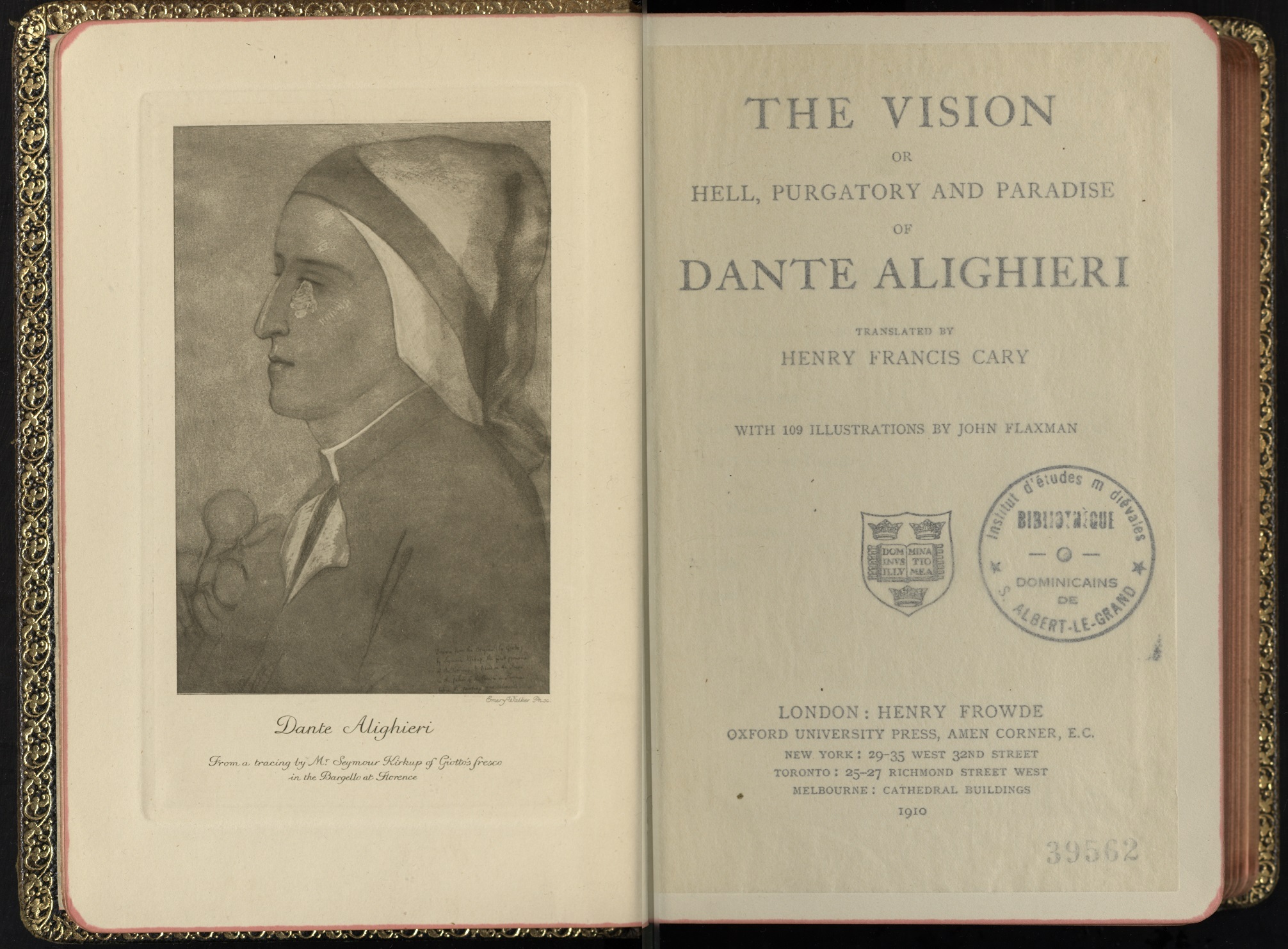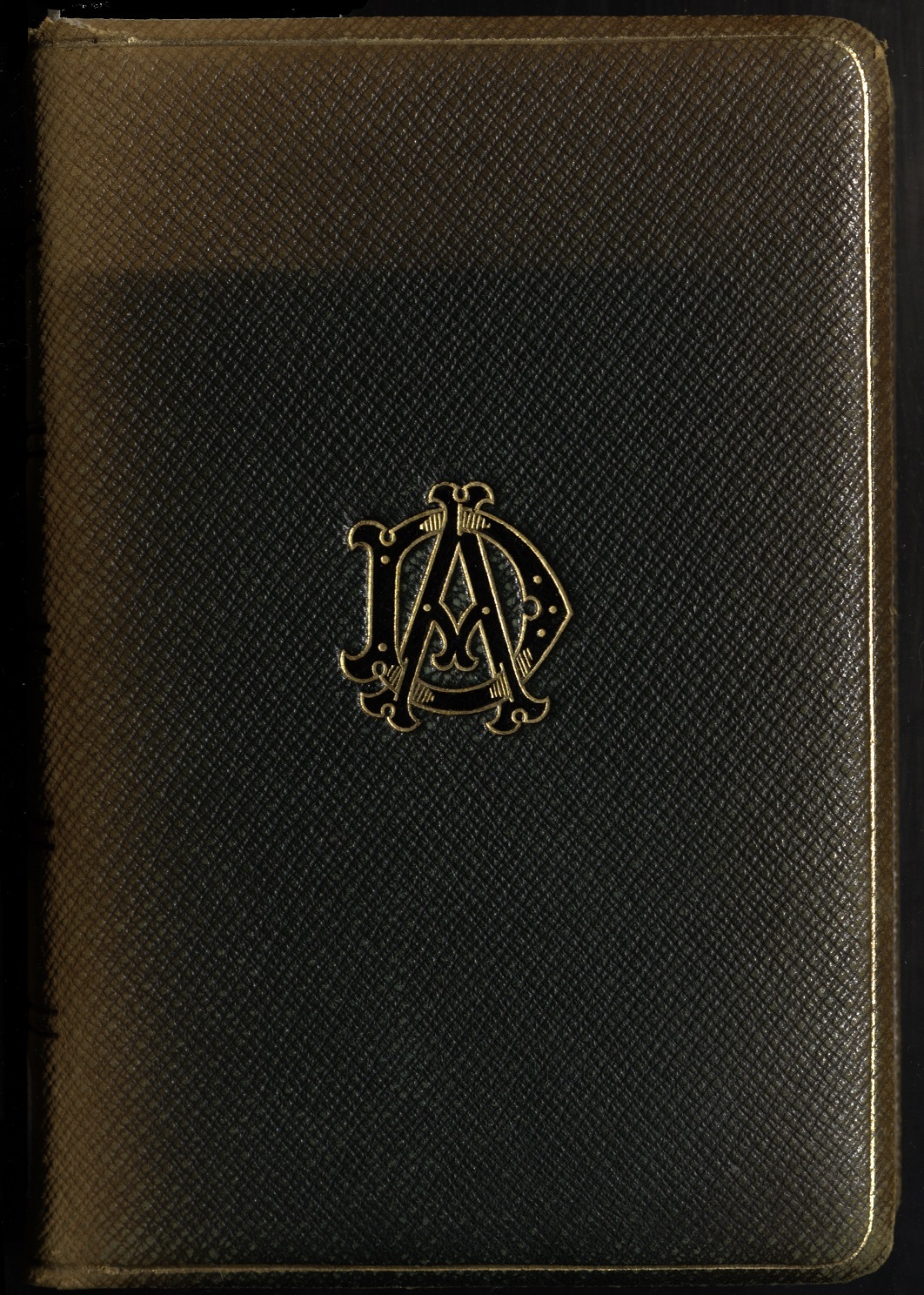The Vision or Hell, Purgatory and Paradise of Dante Alighieri
The Vision contains the three canticles of Dante’s Comedy following Henry Francis Cary’s English translation and illustrations realized by John Flaxman. The layout of the volume arranges the poetic verses written out in columns, interposed by the illustrations, which are reproduced in a small format.
Cary was a devout man and English scholar. In 1814, he published an English translation of the Comedy, in free verse, which was able to stimulate greater interest for Dante’s work in Britain. The success of his efforts was, among others, supported by the enthusiastic reports of poets Ugo Foscolo and Samuel Taylor Coleridge. If Cary’s was not the first English translation to be published, it is without doubt the one that best responds to the interest of Romantic readers, as it transforms the Comedy into a kind of Miltonian work (Braida 2004, 51). A clear departure from the original Italian to English is already evident in the title: it is no longer The Divine Comedy, but The Vision. The religious aspect is overshadowed by the visionary and dreamlike character of Dante’s journey.
John Flaxman was an English sculptor and illustrator. He resided in Rome for many years, where he illustrated the Iliad, the Odyssey, the Tragedies of Eschyle, and the Comedy. The 110 illustrations made for Dante’s poem were commissioned by banker and collector, Thomas Hope, and engraved by Tommaso Piroli (Irwin 1979, 152). Flaxman’s neoclassical, often minimalist, style follows the account with particular interest to Dante the character, the protagonist of the voyage across the three realms. The first edition of illustrations was published in Rome in 1802, preceded by a private edition for the sponsor.

The association of Cary and Flaxman in the same volume offers readers a particular interpretation of the Comedy, in the middle of an artistic space where neoclassicism and romanticism intersect. In this union, the Christian element of the poem, though always present, remains in the background of the protagonist’s actions.
The copy held by the Université de Montréal belonged to Quebec politician, Télesphore-Damien Bouchard (Guttman 2009, 179). Bouchard was a deputy and senator, minister, and president of the legislative assembly of Québec. Despite his well-known anticlerical sentiments, he had some religious friends, particularly Dominican Friars. At his death, some of his books were integrated into the Saint-Hyacinthe Library collection, while the rest were donated by his daughter Cécile-Éna to the Albert-le-Grand Library managed by the Dominicans of the Institut d’études médiévales. Other than The Vision, Bouchard gave a copy of the Comedy with comments by Niccolò Tommaseo and of the Dizionario dantesco by Giacomo Poletto. The collection of the Institut is present in the patrimony of l’Université de Montréal, who acquired it in 1995.

Full title: The Vision or Hell, Purgatory and Paradise of Dante Alighieri, translated by Henry Francis Cary, with 109 Illustrations by John Flaxman.
Author: Alighieri (1265-1321), Henry Francis Cary (1772-1844, translator), John Flaxman (1755-1826, illustrator).
Content: English translation by Henry Francis Cary of the Comedy, preceded by a biography of Dante and a chronology of Dante’s time.
Date of publication: 1910.
Place of publication: London, United Kingdom.
Publisher: Oxford University Press.
Physical description: paper, 578 p., 109 illustrations. 195 x 125 mm. Green Moroccan binding with gold impressions and the diagram of D and A. On the back, gilded title “The Vision of Dante” and, below, the place “Oxford”. Golden edges. 109 illustrations by John Flaxman printed within the text.

Call Number: Université de Montréal, Bibliothèque des livres rares et collections spéciales, Collection de l’Institut d’études, PQ 4315 C322.
Catalogue: https://umontreal.on.worldcat.org/oclc/714942459
Known owners: Télesphore-Damien Bouchard (1881-1962), Cécile-Éna Bouchard, (1906-1987); Institut d’études médiévales.
Ex-libris and Stamps: on the front cover, label “Université de Montréal | Bibliothèque des lettres et des sciences humaines” glued to cover the label “Institut d’études médiévales. Bibliothèque. Don de l’honorable sénateur T.D. Bouchard et de sa fille Ena Cécile”. On the frontispiece, access number 39562. On the front of the first endpaper, on the frontispiece, on page 578 and on the envelope glued on the back cover, the stamp “Institut d’études médiévales | Bibliothèque | Dominicains de | S. Albert-Le-Grand”.
Bibliography
Braida, Antonella. 2004. Dante and the Romantics. New York: Palgrave Macmillan.
Guttman, Frank M. 2009. The Devil from Saint-Hyacinthe, Bloomington: iUnivers.
Irwin, David. 1979. John Flaxman: 1755-1826. Sculptor Illustrator Designer. London: Studio Vista-Christie’s.
Author and date of the record: Alessio Marziali Peretti, 29/05/2021.
English translation: Brittany Buscio.